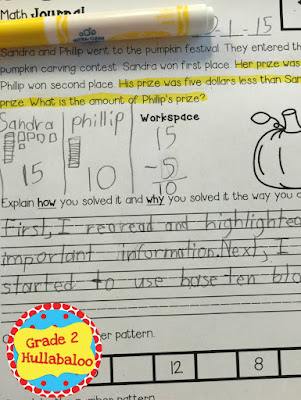We have been working on solving story problems. Solving story problems involves a two-pronged set of skills for second graders. First, they must be able to comprehend the message of the story while using strategies in their toolbox to solve it. The second, more difficult, prong is that of explaining how and why they solved it the way they did.
Dissecting their thinking process is challenging, because children have to stop and think about what they've just thought about! If I were a complete teacher nerd, I would throw out the term meta cognition. BTW, I am a complete teacher nerd, as one of my friends calls herself. It's a compliment! Back to the point...
So many of the steps in solving a problem take place rapid-fire in children's minds. The question asks how many in all. I know I have to add. These two thoughts may only take a split second, and a child might not be aware that they just thought through those steps. I use think alouds to help my students analyze their thinking to explain how and why they solved a problem. This process takes some patience and many examples of modeling, but I believe the time invested is worth it. Below is how I do it.
First, we read the problem. I start explaining what I know, and what I think the 'boss' is. The boss is question. I explain to my students that I often talk through math problems, because hearing it helps me to understand it. I'll have them whisper into the palm of their cupped hand what they did. We do this in every subject! I'm convinced that this helps them organize their thoughts before sharing them with the class or before writing them on a practice page.
As we are finding the boss, we also highlight the keywords. We also highlight the boss. I'll ask them to give me a "Woo" or some other silly sound when they hear an important word as I read the problem aloud. This keeps everyone engaged. Once the keywords have been identified, I'll think aloud about the boss. What is it asking me to do? Are there some words there that give me a hint about which operation I should use? I pause here to review which operations we use in second grade. They really need this review of proper math terms! I make a big deal of explaining how I know to add or subtract. "I know that I should add here, because the boss is asking me to find how many there are in all."
Once I'm sure of my operation, I'll think aloud about how I could show this in the workspace. "I could draw a picture," I might say. "Or, I could use tally marks." Once I decide how I'm going to illustrate solving the problem, again, through thinking aloud, I'll illustrate, and then begin writing my explanation.
I'll start from the beginning and write what I said in my think aloud. I'll ask for help from the audience. I'll ask them to whisper into their hand what they think I should write next. Again, engagement! Below is a photo of one of the problems I recently modeled. In this particular example, I use BOLO (be on the lookout) as a fun way to engage the children in finding keywords and the boss. I told a wacky story about a police dispatcher giving a BOLO for the boss of a story problem. It was corny, but my sweet kiddos laughed!
Once I've modeled the problem and how I explain my thinking, I wash the whole thing down the virtual drain and have the children try it on their own. I don't mind if they mimic some of what I did and said, because it provides a safety net to help them structure their response. We do the same thing the next time I have a story problem for them. And the next... and the next... until I see that most of them understand the process. If there are some who need small group intervention, I'll pull them aside to walk them through the process.
On this particular day, I was lucky to have a substitute SPED TA in my room helping me. She is a veteran third grade teacher who gave me a great compliment on this process. I was very gratified that someone with third grade expertise gave me the thumbs up!
I hope this gives you some ideas for helping your students draft constructed responses for story problems! Your third grade teachers will thank you!
The story problem in the photo is from my October Story Problems resource, found here.
Happy Wednesday!




No comments: